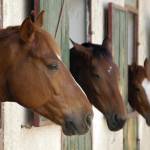Disaster Planning

Horses thrive on routine. For the most part, they stay healthiest and most contented when the same things happen in the same way at the same time every day. Suppose, however, that unexpected events—floods, fire, winter storms—play havoc with horse management. As horse owners put together a disaster plan and cope with difficult situations, one of the first concerns should be minimizing changes in all phases of management.
If your property is in a flood-prone area:
- Do some pre-planning. Have an evacuation route located; store feed, chemicals, and pesticides where water can’t reach them; build mounds in pastures so livestock can get up out of deep water.
- During a flood, get animals out of barns before they can be trapped by rising water. Provide horses with plenty of hay and clean drinking water.
- A few days of walking in shallow water can usually be tolerated by most large animals. After the water goes down, watch horses for disease signs: fever, lameness, difficulty breathing, muscle twitching, swelling or edema, feed refusal.
- Inspect stored feed and hay for dampness or contamination by chemicals and pesticides.
- Check fields and fence rows for debris, and remove dangerous material before turning horses out. Use fly spray to control insects that tend to proliferate after flooding.
- Avoid driving vehicles and machinery on wet fields. Pastures and hayfields (alfalfa, fescue, orchard grass) can survive several days of fresh-water flooding, and silt can be left on fields if it isn’t more than a few inches deep. Weed control may be needed in stressed fields. Contact the local agricultural extension service for advice about soil tests and fertilizing.
Before fire happens:
- Do some pre-planning. Write out a fire plan. Post it. Practice it.
- Save human life first; then animals; then buildings and property.
- No barn is fireproof. Electric wires, hay, bedding, tack, and furniture in offices can all be involved in a blaze. Install fire extinguishers, practice using them, and have them serviced regularly.
- Horses removed from a burning barn should be enclosed in a paddock or field upwind of the fire to keep them from re-entering the burning building.
- Aside from visible injuries, horses may be impacted by smoke inhalation. Have a veterinarian examine horses after a fire.
If your property is in danger of severe winter storms:
- Do some pre-planning. Keep enough hay and grain on hand to feed for several days without restocking.
- Spread sand on ice and frozen ground to help with footing for horses and humans.
- Provide plenty of hay and fresh water. Extra hay is more important than increased concentrates in maintaining body heat.
- Watch for shivering, and provide shelter or a windbreak (hay bales stacked outside a fence can cut wind chill significantly). If animals are brought into a barn, be sure to provide adequate ventilation. Barns should not be air-tight.
- Give animals extra bedding in stalls and run-in sheds. Spreading hay outside will help to insulate animals that lie down on snow or ice.
- Check fences, dangling tree limbs, and downed power lines during and after the storm before turning horses out.
Think, plan, be ready. No one wants to dwell on problems that might occur. Nevertheless, adverse conditions can impact horse operations, stressing equines and humans alike. Having a plan can help, and maximizing continuity in stable management can go a long way toward limiting problems in the wake of disaster.








